The driverless car revolution’s birthplace is the Bay Area, and for years San Francisco residents have borne witness to all its iterations of oddly festooned vehicles roaming the streets with a watchful human babysitter at the wheel.
The training wheels are finally coming off. In the past few weeks, San Francisco has become the first major U.S. city where autonomous vehicles have provided fully driverless rides to members of the public, according to Cruise, the company providing the rides.
To catch a glimpse, you’ll need to be a night owl: rides are only occurring from 11 p.m. to 5 a.m. and within a specific part of the city, pictured below. And to get a ride, you’ll need to be admitted off the public waitlist.
The number of riders thus far seems small: Cruise won’t share any numbers, but the Cruise CTO Tweeted they are “being cautious and careful with this rollout.” Some reports have been trickling onto social media. The Standard talked to several who had taken rides, who said they got off the waitlist through being “friends and family” of Cruise employees. For now, rides are free (Cruise does not yet hold a permit to charge for rides.)
Corona Heights resident Aaron Dence took six rides on Valentine’s Day from cars named “Torta,” “Boogie” and “Disco.” He said the cars would pull over and turn on their hazards when picking him up and exhibited human-like driving characteristics that surprised him, like pulling up to a stop sign and then “edging its way into making a turn.” The cars are also equipped with speakers where you can communicate with a live customer support representative, he said.
I hailed a driverless @Cruise car last week, and now I will never look back. This moment is even bigger than when I got my 1st generation iPhone. I had an inkling that it would change the future. pic.twitter.com/Gh2ZZQN6gA
— Aaron Dence (@amaddama) February 23, 2022
Driverless car technology has the potential to dramatically decrease costs for riders: Cruise said that it intends to keep its costs to $1 to $1.50 per mile and charge less than the $5 per mile that Uber and Lyft charge in San Francisco. That means that taking a driverless taxi could be on par with the cost of the Muni. The cars are also 100% electric.
Cruise is the first company to offer fully driverless rides in San Francisco. Waymo, a subsidiary of Alphabet, has been operating a commercial driverless fleet in the town of Chandler, Arizona, outside Phoenix – a far less demanding environment than SF – since late 2020. Waymo also declined to share any numbers, but a spokesperson said they offer “hundreds” of rides per week and they have served “thousands” of users.
In San Francisco, Waymo currently operates a human-monitored self-driving fleet that has served “hundreds of public riders” with “over ten thousand more on the waitlist.”
Glen Park resident Jeremy Conrad said he was nervous when he hailed his first ride. He pulled out the app, which he said looks “very similar to the Uber app,” and a car without a driver pulled up. He got in, feeling “surreal.”
“The first turn into the traffic, you’re like, ‘Oh God, is this going to work?’” he said. “But honestly it was awesome. The thing that blew my mind was how smooth it was. It was way smoother than most Ubers I take.”
And by the end of the ride, it seemed like such a new normal that he found himself pulling out his phone, just like he always does.
